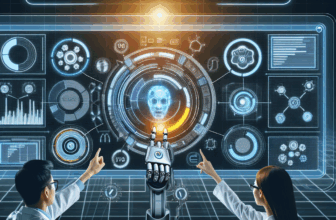Enhancing Customer Experiences: The Power of Automated Journey Optimization and AI Benefits
Table of Contents
- 1. Understanding Customer Experience
- 2. The Evolution of Customer Journey Mapping
- 3. The Role of Automation in Customer Journey Optimization
- 4. Leveraging AI for Enhanced Customer Experiences
- 5. Case Studies on Automated Journey Optimization
- 6. Future Trends in Customer Experience Automation
- 7. Frequently Asked Questions (FAQ)
- 8. Resources
1. Understanding Customer Experience
Customer experience (CX) refers to the overall perception that customers have of a brand or company based on their interactions across various touchpoints. Understanding CX is crucial as it influences customer loyalty, retention, and satisfaction. Companies that prioritize CX tend to outperform their competitors, making it a pivotal focus for businesses in the digital age.
1.1 The Importance of Customer Experience
In today’s market, customers have a plethora of options at their disposal. Therefore, creating exceptional experiences is vital for differentiation. Research shows that customers are willing to pay more for a better experience, and brands that invest in enhancing CX are more likely to see increased customer loyalty and advocacy.
1.2 Key Components of Customer Experience
The multi-faceted nature of customer experience can be distilled into several key components, including:
- Emotional Connection: The feelings that customers associate with their interactions.
- Usability: The ease with which customers can navigate and utilize a product or service.
- Personalization: How well the offerings cater to individual customer preferences and needs.
- Accessibility: The extent to which customers can reach and engage with the brand across platforms.
2. The Evolution of Customer Journey Mapping
Customer journey mapping is a visual representation of the process a customer goes through to achieve a goal with a company, from awareness to purchase and beyond. It provides insights into customers' thoughts, feelings, and potential challenges at each stage.
2.1 Historical Background
The concept of journey mapping began gaining traction in the early 2000s as customer-centric strategies emerged in industries. It evolved from simple linear paths to more dynamic, multi-channel frameworks, adapting to changes in consumer behavior propelled by technological advancements.
2.2 Modern Customer Journey Mapping Techniques
Today, journey mapping employs various digital tools and analytics to provide a more in-depth understanding of customer behaviors and preferences. Techniques range from qualitative research, like customer interviews and focus groups, to quantitative methods such as surveying customer interactions across platforms.
2.3 Challenges in Journey Mapping
Despite its importance, organizations often face challenges in journey mapping, including:
- Data Silos: Limited sharing of customer-related data across departments can lead to incomplete insights.
- Dynamic Customer Behaviors: Rapidly evolving consumer preferences and behaviors can render traditional mapping ineffective.
- Resource Intensive: Gathering insights and maintaining updated maps requires significant time and investment.
3. The Role of Automation in Customer Journey Optimization
Automation plays a crucial role in enhancing the customer journey by streamlining processes, personalizing interactions, and ensuring timely responses to customer needs.
3.1 Streamlining Interactions with Automation
Automated systems such as chatbots or CRM tools can handle routine customer inquiries, allowing human agents to focus on complex problems. This optimizes customer interactions by providing quick resolutions and maintaining engagement.
3.2 Personalization Through Automation
Advanced automation solutions can analyze customer data to tailor recommendations and content delivery based on individual preferences. Personalization at scale fosters deeper emotional connections with customers and enhances satisfaction.
3.3 Timeliness and Relevance of Interactions
By using automation, businesses can ensure that their communications are timely, sending reminders, follow-ups, or promotional offers precisely when customers are most likely to engage. This minimizes missed opportunities and improves overall customer experience.
4. Leveraging AI for Enhanced Customer Experiences
Artificial Intelligence (AI) technologies have revolutionized how businesses approach customer experience optimization. By leveraging AI tools, organizations can glean insights from massive datasets, driving changes that significantly enhance the customer journey.
4.1 AI-Powered Analytics and Insights
AI tools can sift through vast amounts of data to uncover trends and customer preferences, which can inform better decision-making. Predictive analytics, for instance, allows businesses to anticipate customer needs, enhancing the likelihood of successful interactions.
4.2 Chatbots and Intelligent Virtual Assistants
Implementing AI-driven chatbots can provide 24/7 assistance, enhancing customer experience by delivering immediate responses to common inquiries. These intelligent virtual assistants can learn from interactions, improving over time to meet customer expectations.
4.3 Personalization Through Machine Learning
AI employs machine learning algorithms to provide hyper-personalized experiences at a scale previously deemed impossible. By adjusting to user behavior dynamically, AI ensures that recommendations evolve in real-time, significantly impacting customer engagement.
5. Case Studies on Automated Journey Optimization
The applications of automated journey optimization in real-world scenarios highlight its potential and effectiveness in enhancing customer experiences.
5.1 Case Study: Starbucks
Starbucks employs both AI and automated systems to create a seamless customer experience. Through its mobile app, the company allows customers to place orders, customize drinks, and even set up subsequent reminders for their favorite items, enhancing customer convenience and satisfaction.
5.2 Case Study: Amazon
Amazon utilizes a sophisticated recommendation algorithm that analyzes customer behaviors to suggest products. This personalization, driven by AI, significantly boosts conversion rates by presenting relevant offers, reflecting how automated journey optimization can impact sales.
5.3 Case Study: Sephora
Sephora's chatbot, named Sephora Virtual Artist, allows users to try on makeup virtually and receive tailored product recommendations based on their preferences. The integration of AI and automation in this approach has revolutionized how customers engage with the brand.
6. Future Trends in Customer Experience Automation
The landscape of customer experience is constantly evolving, driven by technological advancements and changing consumer expectations. Looking ahead, several trends are set to shape the future of automated journey optimization.
6.1 Integration of Augmented Reality (AR)
The use of AR in customer interactions is gaining momentum, allowing users to interact with products in a virtual environment. This immersive experience has the potential to enhance customer engagement and provide personalized experiences that are interactive and memorable.
6.2 Advanced Predictive Analytics
As businesses collect more vast datasets, the ability to utilize advanced predictive analytics will become essential. Organizations can anticipate trends and customer preferences more accurately, leading to improved decision-making and strategic planning.
6.3 Omnichannel Strategies
Customers increasingly expect seamless interactions across different channels. Businesses will need to adopt omnichannel strategies, ensuring that customer journeys are smooth and consistent regardless of the platform used, reinforcing the importance of integrated automation at every stage.
7. Frequently Asked Questions (FAQ)
Q1: How does automated journey optimization improve customer experience?
Automated journey optimization streamlines processes, reduces friction in interactions, and ensures personalized engagements, all of which contribute to enhancing overall customer satisfaction and loyalty.
Q2: What technologies are involved in customer journey automation?
Technologies such as AI, machine learning, chatbots, CRM systems, and analytics tools play integral roles in automating and optimizing customer journeys.
Q3: Are there any risks associated with automation?
Yes, potential risks include over-reliance on automated systems, which can lead to a lack of personalized human interaction. Organizations need to balance automation with personalized customer service to cater to diverse customer needs.
Q4: How can small businesses benefit from customer journey automation?
Small businesses can enhance customer engagement and efficiency by using cost-effective automation tools that cater to their unique needs—such as automated email campaigns or CRM systems designed for small enterprise functionalities.
8. Resources
| Source | Description | Link |
|---|---|---|
| Forrester Research | In-depth reports on customer experience trends and analytics. | Forrester Research |
| Gartner | Resources on customer journey mapping and automation strategies. | Gartner |
| HubSpot | Guides on automation tools and their impact on customer experience. | HubSpot |
| Harvard Business Review | Articles and case studies on innovative customer experience strategies. | Harvard Business Review |
| User Testing | Insights into customer journey mapping and best practices for UX. | User Testing |
Conclusion
In conclusion, enhancing customer experiences through automated journey optimization and AI is not just a trend but an essential aspect of modern business strategy. The integration of advanced technologies is enabling organizations to better understand their customers, streamline processes, and foster deeper relationships. As businesses adapt to the ever-changing consumer landscape, the importance of focusing on customer experience will only grow. Future trends suggest that advancements like AR, predictive analytics, and omnichannel strategies will further revolutionize customer interactions.
Organizations are encouraged to remain agile, leveraging technology while ensuring that the human element remains integral to customer experiences. Continuous learning and adaptation will be key to sustaining success in the journey ahead.
Disclaimer: This article is produced by A.I. during Beta Testing. The information provided is for educational purposes only, and readers are encouraged to conduct additional research before implementing strategies discussed in this article.










